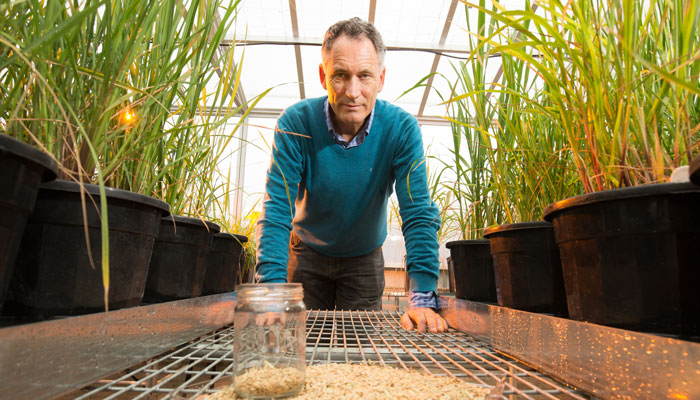Throughout its 54-year history, Macquarie University has collaborated with industry on research that has had significant Australian and global impact, including the development of WiFi technology, novel parasite detection that keeps drinking water safe and drought-resistant crops.

Field trials: Drought-resistant crop technology developed by Professor Brian Atwell has been licensed by a multinational chemical producer.
Macquarie’s invention of Wi-Fi has affected millions of people worldwide. In the early 1990s Professor David Skellern, then head of the Department of Electronics, teamed up with Dr Neil Weste and colleagues at the CSIRO to develop a new radio-transmitting microchip that was small, reliable and economical – the building block of Wi-Fi.
Skellern and Weste established Radiata Communications to commercialise their idea and received venture capital funding from Cisco Systems, the multinational telecommunications corporation and a semiconductor company. Cisco eventually bought out Radiata and hired Skellern as the technology director of their new wireless business.
- Internet download speed rockets to 10 gigabytes per second using 'magic' chip
- Cracking the mysteries of a summer lunch favourite
“Having access to our expertise and IP means companies can leapfrog over competitors to develop new technology. With an exclusive IP monopoly this gives them a significant return on their investment,” says Anna Grocholsky, Macquarie’s Director of Commercialisation and Innovation.
With access to the university’s facilities, companies can also test out new ideas without taking the risk of creating a new lab. “They can have instant cross-faculty assistance and work with our researchers. In return they can acquire the exciting Intellectual Property rights that come out of the collaboration,” says Grocholsky.
Having access to our expertise and IP means companies can leapfrog over competitors to develop new technology.
Macquarie has also collaborated with Sydney Water for more than 20 years.
After waterborne parasites Giardia and Cryptosporidium were found in Sydney’s water, Macquarie’s Professor Duncan Veal and a cross-faculty team of microbiology and opto-electronics researchers started investigating the problem. Using antibodies and nucleic acid probes, they developed a novel detection mechanism, which targeted the parasites and labelled them with fluorescent markers.
This technology is still used throughout the world and the collaboration with Sydney Water continues today.
Breakthroughs from cropping to keyhole surgery
Another industry partnership developed after Macquarie Professor Brian Atwell and his team spent more than 10 years researching drought-resistant wild rice. BASF – the largest chemical producer in the world – has now licensed the technology from Macquarie and is conducting field trials with commercial drought-resistant wheat. This could help feed people globally as temperatures continue to break records.

Opportunities: Anna Grocholsky, Macquarie’s Director of Commercialisation and Innovation.
A recent medical collaboration involves Professor John Cartmill and Dr Andrew Gilmore from Macquarie University Hospital. The colorectal surgeons have created a new surgical device to use in keyhole abdominal surgery, which will make surgery more time-efficient. Macquarie has signed a licence with Multigate Medical Products to commercialise their invention.
“The university created a 3D-printed prototype of the device, which we used to help get the surgeons an industry partner,” says Grocholsky. “Multigate Medical Products will fund the full development of the product, complete the regulatory work and take it to market – hopefully this year.”
To inquire about forming an industry/research partnership contact the Office of Commercialisation and Innovation - innovation@mq.edu.au, or Anna Grocholsky directly on +61 437 463 317



